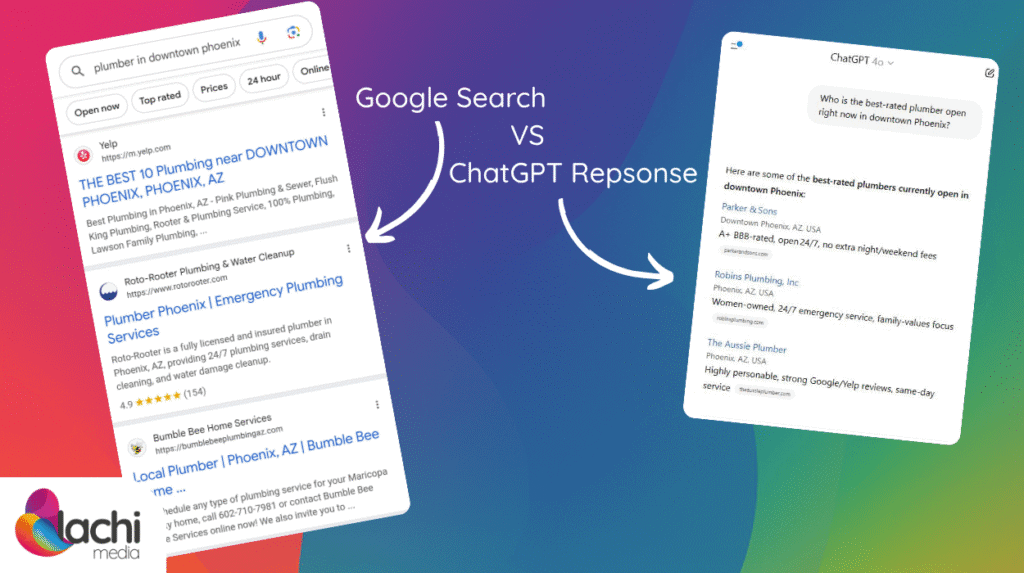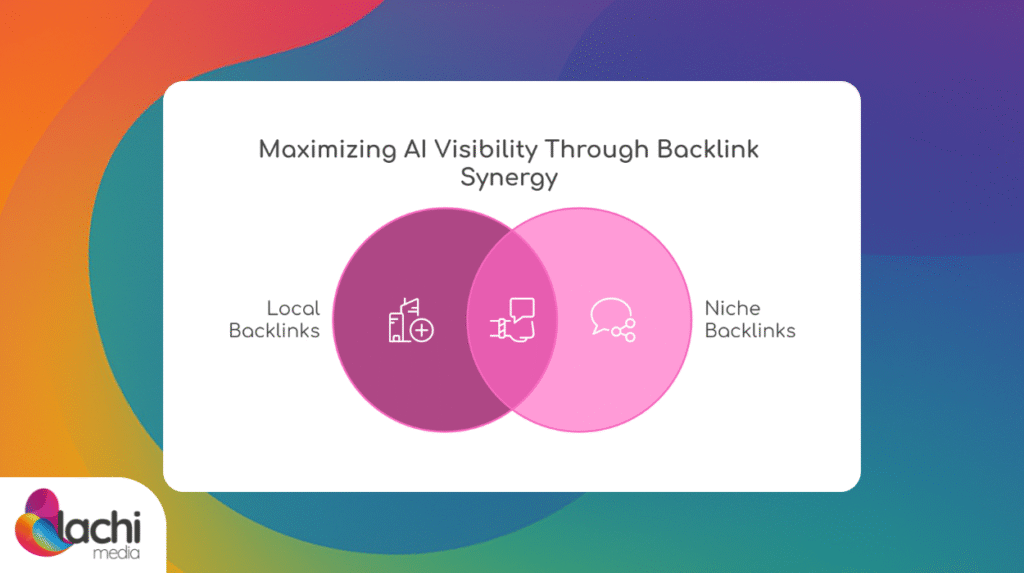Last Updated on September 19, 2025
Search has changed. Customers aren’t typing “plumber near me” into Google anymore (actually, they still do – for now). They’re asking ChatGPT, “Who’s the best plumber in Denver that’s open now and accepts emergency calls?”
And here’s the kicker: AI chatbots only give 3–5 results. If your business isn’t on that shortlist, it might as well not exist.
So, how do you make sure AI includes you in the answer? You stop thinking about old-school SEO and start optimizing for visibility in AI-driven search.
As search behavior shifts from traditional engines like Google to conversational AI platforms such as ChatGPT, Gemini, and Bing Chat, local businesses must adapt their SEO strategies. Being visible in these new environments isn’t just a bonus; it’s the new baseline for staying competitive. Here are the best practices for ensuring your business is discoverable by AI chatbots in 2025.
Table of Contents
ToggleThe AI Search Revolution
AI chatbots are fundamentally changing how users seek and receive information. Instead of typing fragmented keywords like “plumber near me,” users now ask full questions like, “Who is the best-rated plumber open right now in downtown Phoenix?” These tools respond with 3 to 5 curated options, and if your business isn’t one of them, you’re effectively invisible.

Best Practices to Implement in Your Website to Make AI Chatbots Recommend Your Business
1. Create and Upload an LLMS.txt File to Your Site
Most websites don’t use a properly formatted llms.txt yet, and this is a great opportunity for you go get ahead. An llms.txt file helps large language models (LLMs – like ChatGPT, Claude, Gemini, Perplexity, etc..) understand youe site, products and services.
It follows a simple format you can see here, but to simplify things, I made a custom GPT you can use to make yourself a properly formatted and optimizied LLMS.txt file. Here is the free LLMs.txt GPT.
2. Implement Schema Markup Correctly
AI relies heavily on structured data to understand and categorize your business. Schema markup provides this structured context, enabling AI to confidently recommend your business for relevant queries.
- Use LocalBusiness schema with complete details: business name, address, phone number, hours, and geo-coordinates
- Apply FAQPage schema to every service or product page
- Use tools like Schema Pro or RankMath on WordPress
- For manual creation, use TechnicalSEO.com’s Schema Markup Generator
Quick Tip: Always validate your markup using Google’s Rich Results Test to ensure accuracy.
3. Reframe Content in Natural Q&A Format
AI language models understand and prioritize conversational content. Matching your site’s language to the way people talk to AI will boost discoverability.
- Use a natural tone at a 6th–8th grade reading level
- Add 3 to 5 FAQs on every service and location page
- Reflect real customer questions, such as:
Q: Do you accept insurance? A: Yes, we accept most major providers including Aetna, Blue Cross, and Cigna.
Q: Can I walk in without an appointment? A: Walk-ins are welcome Monday through Friday until 3 PM.
Q: Are you open on weekends? A: We’re open 9–5 on Saturdays and closed Sundays.
4. Create High-Quality, Location-Specific Pages
AI models detect and penalize low-value, duplicated content. Creating truly unique local pages is essential:
- Each location page must have a unique title, meta description, and introduction
- Include images relevant to the service and location
- Add testimonials from clients in that region
- Use a local FAQ section based on regional inquiries
Avoid shortcuts like duplicating the same content and swapping out city names, AI can detect thin content and will probably ignore it.
Another tip that has the potential to really help is to divide your content into neighborhoods as well, rather than just creating pages for each city. Both Google and AI chatbots would appreciate this granular approach.
5. Collect Good Reviews Effectively Across Multiple Review Aggregators
Imagine a user asking ChatGPT “who’s the best plumber in Alpha Park, Alpharetta, GA?”.
To find “who’s the best”, ChatGPT (or one of the other LLMs) looks for reviews and services that are usually mentioned in review aggregators (such as openning hours, emergency service availability, whether a business is family owned, run by a veteran, available for same day service, etc…
List your Business on aggregators like Yelp, BBB, Yellow Pages, and TrustPilot. Set up a Facebook page, start a Google Business Profile (formerly GMB), and sign up your business in as many niche-specific business listings (Angi, Thumbtack, HomeAdvisor, Houzz, Porch, etc).
Just like in the previous point, make sure to keep the content as unique as you can.
Once you have all these profiles set up, you need to start collecting reviews. There are some services that help with that (and also help avoid receiving bad reviews in a legal way), and this is also something we integrated into our services, so our clients get a review management service for free as part of the service.
If you need a suggestion, we’ll be happy to advise and help whether or not you’re our client.
6. Feature and Structure Reviews Strategically
User sentiment is highly influential in AI’s rankings.
- Encourage happy clients to leave reviews on Google, Yelp, and niche platforms
- Embed 3 to 5 recent reviews on each service page
- Use the Review schema to structure them for better parsing
Example: “Fast, professional service. The team arrived on time and fixed everything in under an hour! Highly recommend.”
7. Refresh Content and Schema Regularly
Keeping content current helps AI systems trust and prefer your website.
- Update service descriptions quarterly
- Recheck and revise schema markup monthly
- Add new FAQs based on customer service interactions
- Rotate fresh reviews, testimonials, and case studies onto relevant pages
Tip: A page updated within the last 30 days typically performs better in AI results.
8. Acquire Backlinks from Local and Niche Sources
Backlinks remain a foundational signal for search engines and AI trust. To boost your AI visibility, focus on acquiring links from:
- Local business directories, newspapers, chambers of commerce, and city blogs
- Industry-specific websites, forums, and associations
- Event sponsorships, local press mentions, or guest features on relevant blogs
Search engines and AI chatbots alike prioritize businesses that are referenced by authoritative, contextually relevant sources. A plumber in Austin, for example, benefits more from being linked in a local home repair blog or Austin news outlet than from a generic global directory.
Combine backlink efforts with content marketing, share useful insights, answer common questions on third-party sites, and link back to location or service-specific pages.

9. Optimize for Voice and Mobile
Most chatbot interactions occur on mobile and via voice input. Ensure your site meets those expectations:
- Mobile-optimized with fast loading speed
- Simple, intuitive site navigation
- Voice-friendly keywords like “best-rated,” “near me,” “open now”
- Use concise headers and quick answers to common questions
Structure pages so that spoken questions easily match the content AI pulls from your site.
10. Monitor AI Mentions and Traffic
AI platforms sometimes mention businesses by name or link to their site. These clicks show up as referrals.
- In Google Analytics, check for sources that are associated with AI chatbots.
- Use UTM tags to track chatbot-generated traffic
- Set up custom alerts for increases in this traffic category
- Regularly test queries like “top-rated [service] in [city]” in AI tools to verify your presence
Here are the most commonly used utm_source parameters added by major AI chatbot platforms:
- ChatGPT / OpenAI
utm_source=chatgpt.com - Microsoft Bing Chat / Copilot (Edge sidebar, Copilot Search in Bing)
Likely uses utm_source=bing.com or utm_source=edgepilot.com, though official confirmation is limited - Google Gemini
Could use utm_source=gemini.google.com or utm_source=gemini, based on standard tracking patterns—though this isn’t universally documented - Perplexity
Commonly appears as utm_source=perplexity.ai when content is shared or clicked - YouChat (You.com)
Tracks via utm_source=you.com, matching the source domain seen in referral data
11. Avoid Common Pitfalls
There are traps that can reduce AI visibility:
- Duplicate content across multiple local pages
- Lack of Q&A or structured formatting
- No schema or outdated schema markup
- Overly complex language or technical jargon
Be vigilant and audit your site regularly.
Finishing Thoughts
In 2025, visibility in AI chatbot results is a critical channel for acquiring new local customers. The businesses that adopt structured schema, conversational content, localized pages, and traffic tracking will earn a place among the few results AI presents to users. Don’t just aim to rank—aim to be the trusted answer AI delivers first.